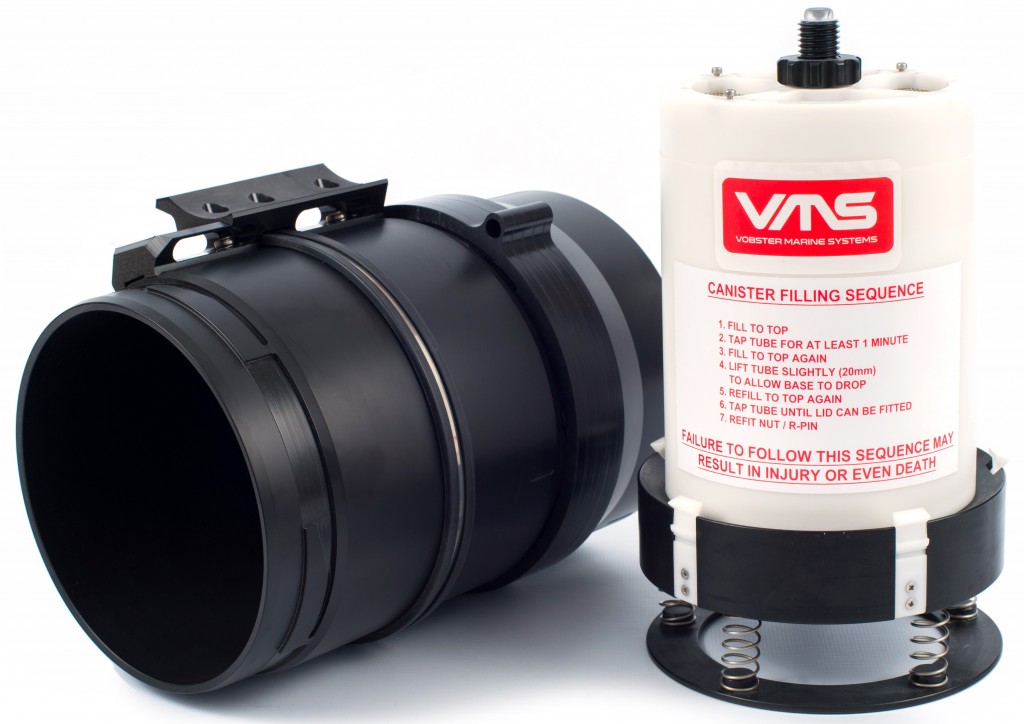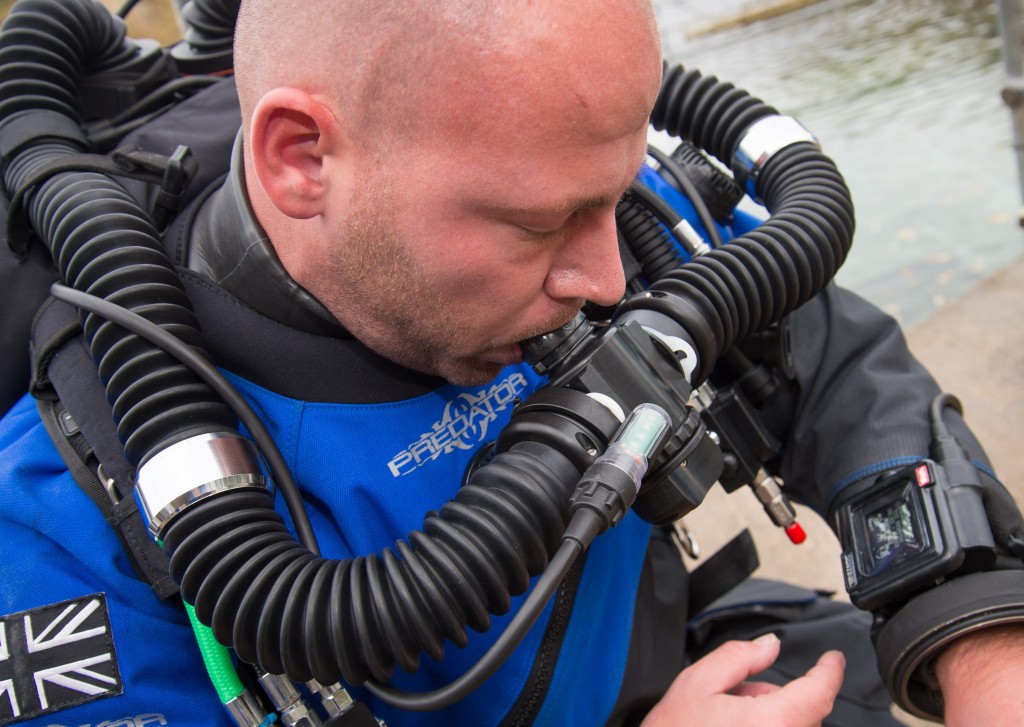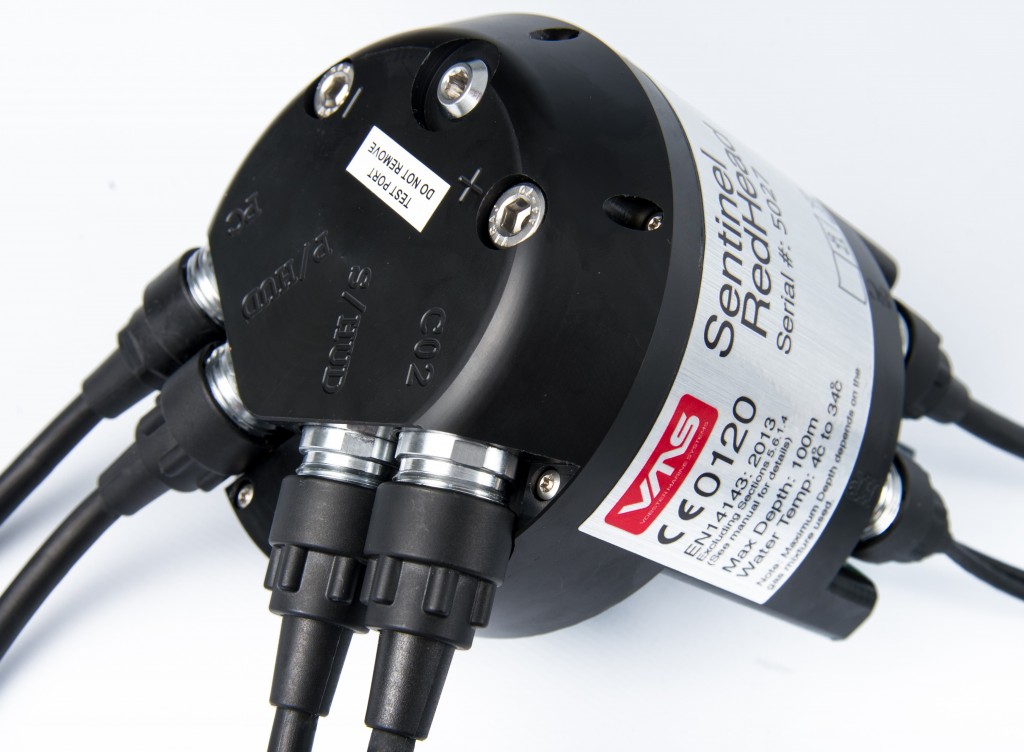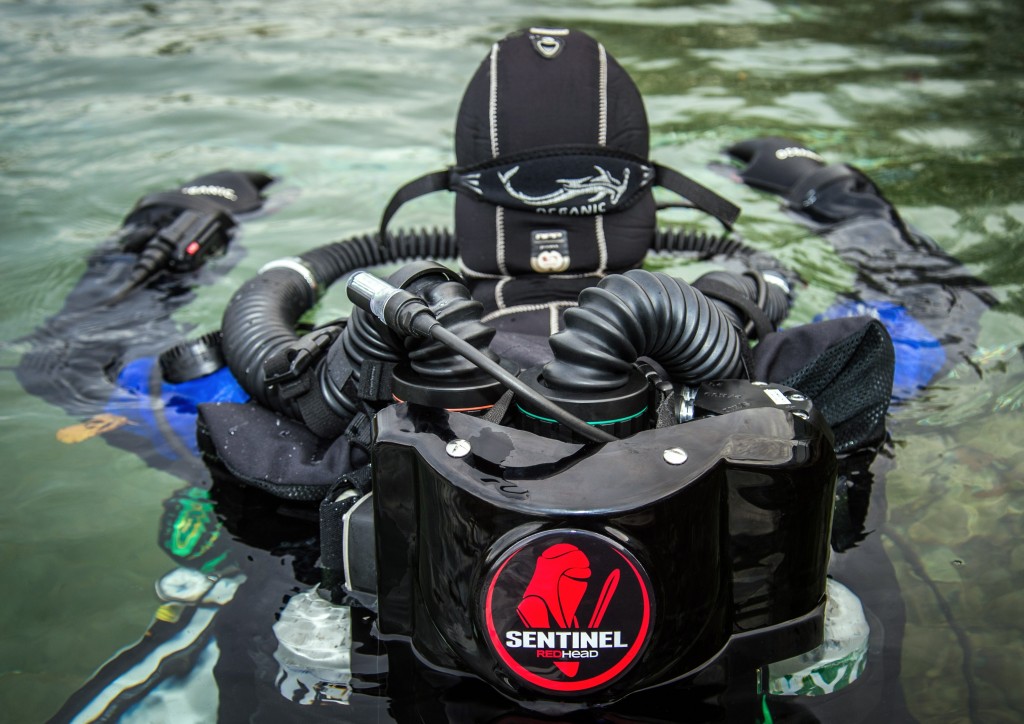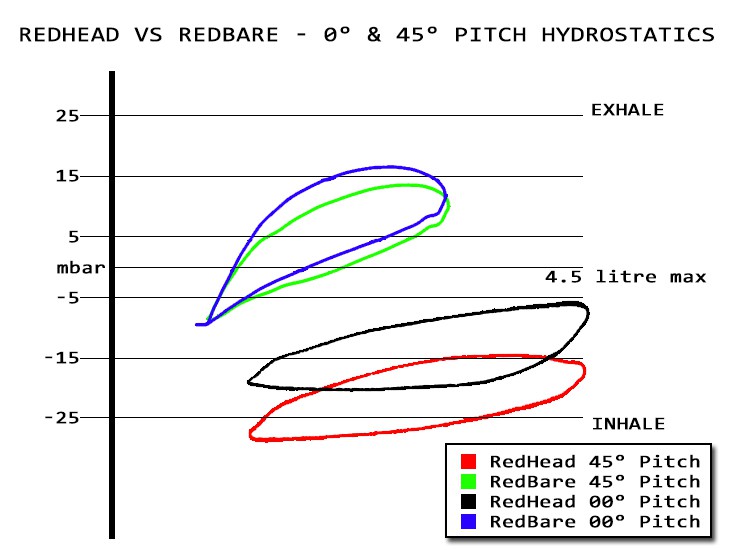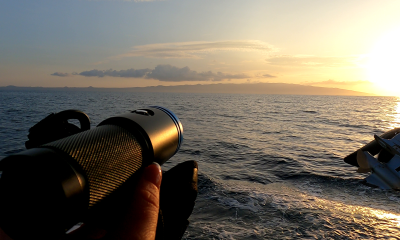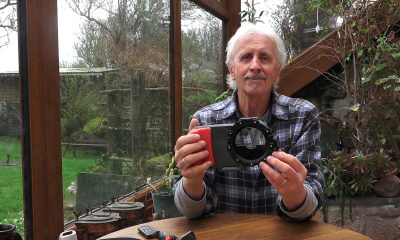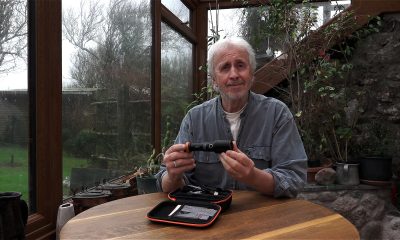Gear Reviews
The VMS RedBare: a Breath of Fresh Air
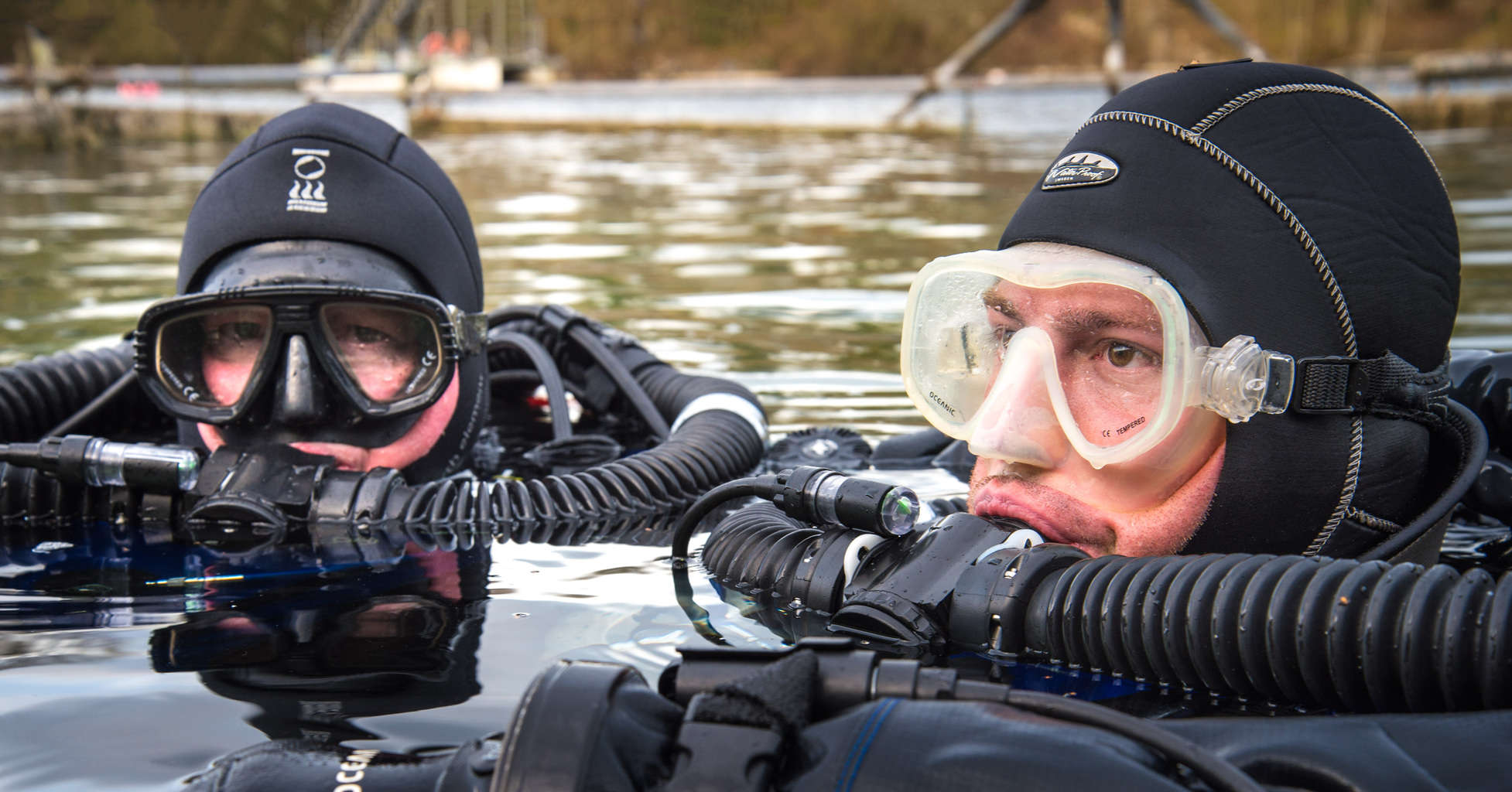
This is a story of two parts….
One part, a thoroughly enjoyable revelation about CCR diving during a series of RedBare CCR test dives, and the other, a delve into what makes the RedBare CCR such a refreshing new / old arrival (we’ll come to that!) on the diving scene.
My journey toward the RedBare CCR began with a conversation about rebreathers in general. I liked the idea of a CCR for my own ambitions and projects, which needed more time, safety and redundancy without carting around excess cylinder loads. However, recognizing that a CCR has more processes to monitor (O2 monitoring and injection, CO2 removal etc.) for these benefits, meant I wanted a system that made CCR diving simple to use, but offered me access to complex information, and chances to resolve dive or unit problems without ending up on open circuit unless absolutely necessary. So… simple and complex all at the same time? How was that going to work?
Rebreathers must do two things to provide us with breathable gas:
Inject O2 and remove CO2. That sounds simple, but then we end up using galvanic O2 cells to monitor the gas, chemistry to remove the CO2, first stages to supply the gas, electronics to make it all work together and then sensors to ensure us that the chemistry is working correctly and thus that the gas afterwards is CO2 free. If all goes well, the numbers need to stack up, and are presented to us in an ‘easy to check’ way. Technical diving means if we need one, then we should take two, so a backup system is needed. Chuck in making sure that we still have enough gas on board, a battery readout and some of that good old fashioned dive data, time and depth – it’s all starting to look a bit like a plane cockpit. But you don’t get a co-pilot or flight engineer – there’s just you. I’m definitely not a fan of using myself as a gas sensor unless the McDonalds reality has hit the fan, so I wanted proper instrumentation.
Let’s start with this conundrum – how can all this be made simple?
The RedBare HUD has an ‘at a glance’ answer – use the computer to compare all these readings to what you asked for. Everything OK – Solid green. Slight issue you can manage? Alternating Blue Green. Imminent dangerous gas – a Flashing Red and a backup buzzer gets your attention. Just for good measure, a white LED gives deco status as stops overhead, at your stop, or too shallow / too fast. OK great – I like simple, but I also like OCD, and I want to verify and double check as and when. Of course, there is plenty more detail on the handsets, especially if you go into the menu’s, but this is the simplest HUD status system available. It really couldn’t be simpler or more intuitive, which is what you want for 99.9% of your dive time.
Monitoring everything also takes us away from the simple ‘gas go round’ rebreather concept and into a proper life support system (LSS) philosophy. The unit does everything it can to keep you alive and well; part of that concept is the early warning system, giving you, the user, the ability to make sensible decisions and course corrections ahead of time. On the RedBare CCR, having a green light doesn’t just mean your PO2 is good, it means that all systems are reporting in happy; it symbolizes a level of system ‘confidence’ to not only continue, but to finish the dive.
But a fancy HUD is nothing without some solid performance to take us on great dives. We need to look at O2 monitoring / injection and CO2 removal. We’ll look at CO2 removal first as everyone loves to chuck durations around in the game of CCR top trumps.
The RedBare has the proven class leading CO2 filter (scrubber, stack, you choose) from the Sentinel at its heart. 2.25kg of Sofnalime delivers the only unit with a 4 hour CE duration under the latest 2013 standard. This fierce test pits harsh loads against the filter, meaning it will last far longer under more benign actual dive conditions. Time to breakthrough in the 40m air diluent test is 140 min, while the 100m trimix DIL test has 47 min to breakthrough. You can ask the others to show you theirs now….
Part of the secret to this performance is the heat generated in the filter by exhaled gas being fed in directly (no exhale counter-lung) and the insulation provided by the returning gas being wrapped around the chemistry.
How do we know it’s working?
There is a line of thermistors inside the filter to measure the temperature (temp drops, less chemistry, HUD flashes, you get safely out of dodge), plus a gaseous CO2 monitor to ensure your next breath has no CO2 in it. That’s a red flashing LED at 5mB, way before you get a headache or wonder what’s going on. The displayed duration remaining is also calculated from the number of solenoid ‘fires’. Each one has a known amount of O2 in, so a known amount of CO2 out, so a known amount of filter remaining. This metabolic rate counter (MRC) leaves a simple timer standing. ‘Smart stacks’ are what we want in the 21st century!
This completes the most comprehensive suite of CO2 and filtration performance and safety monitory available on the market, and was one of the main reasons why I looked at this CCR over others.
Onto O2 – another game of two halves
You need very accurate monitoring to give your computer the best most up to date info to fire the solenoid, or we’re back to ‘rubbish in, rubbish out’ and rubbish PO2 control is just not my cup of tea at 100m! The RedBare uses three sensors, (working better already because it’s hotter, far fewer moisture problems here) to feed info to both the primary and backup systems. The PO2 is sampled from each cell every 75 milliseconds and averaged over 4 seconds in dive mode. The other half is injection – this solenoid can fire tailored bursts from 50 milliseconds upwards depending on if you are replacing metabolised O2 or re-blending richer deco gas on ascent. Either way, the tracking is +/- 0.02 Bar. If wobbly PO2 is like open circuit bouncing on stops, this is nailed on flat and stable, which makes us happy!
During the dive, the addition of O2 performed by the Red Bare’s solenoid was so gentle, the actual injection is so small, I could hardly hear it. As injection takes place through a small bore hose, rapid PO2 increase is virtually impossible, and injection takes place prior to scrubbing, allowing a good mix and better monitoring, and no gas cool down and condensation (dry cells).
When I started looking at a CCR these features had made me interested enough to acquire a bargain basement Sentinel to begin training and which could be eventually upgraded to RedBare CCR. I dived an early, hard wired, expedition model for over 100 hours in all conditions as well as having the opportunity to get approximately 30 hours on an early RedHead model lent to me by Diving Matrix colleague Paul Toomer for several months. I have dived Sentinels in the company of many other CCRs, so I have a clear view of the RedBare improvements and VMS’ dedication to the platform and product. A product that took me from an experienced Open Circuit mixed gas diver who had the intention of really only diving CCR when it was required for the dive, to now being a RedHead CCR Instructor, who prefers diving his unit to any other configuration. And that’s saying something.
OK, so it’s time I talked about what it was like to dive….
Test Diving the RedBare CCR was an utter joy. The work of breathing in particular was utterly spectacular; the counter lungs looks a bit like the original travel edition, but don’t be fooled into thinking they are! After a ton of testing to perfect their position, the VMS nicknamed “side-mount counter-lungs” attach to the sides of the backplate instead of coming over the shoulders, whilst maintaining the centrally connected single lung design. When talking to Martin Stanton, he provided a rather staggering test graph on the hydrostatic WOB illustrating the new lung position by VMS has reduced the inhalation and exhalation effort by such an extent, it has to be tried to be believed. I can honestly say, the new positioning of the counter lung is a true work of art; not only do they sit great, they produce a virtually effortless breathing experience in any position or angle in the water.
I’m gonna be honest with you, I was in a dry suit with boots far too big, and I had (ignorantly) neglected to correct a groin strap that was waaaaay too long, resulting in the unit riding up my shoulders; between that and not getting much air in my legs it was pretty hard work. However the breathe was fantastic (did I mention how easy it was to breathe)? The unit feels so much lighter and smaller; it’s simply stunning. After a quick crotch fettle, I jumped back in, this time with the harness fitted correctly and wow, just WOW.
It felt like diving a 12L cylinder on a backplate. The breathe was so spectacular that I wanted to try something that to my knowledge no other rebreather could manage, so I put my legs up in the air, head towards the bottom, and hovered there like an inverted candle. The work of breathing was STILL just like being on the surface; what an amazing counter-lung design. I surfaced with the biggest grin on my face, and it instantly became apparent why Martin was so keen for me to try it again.
It just goes to show what a difference a correct setup makes, and why it’s worth spending some time on that. What an amazing machine! Needless to say I will be getting one in the very near future.
For those of you who like figures, the mechanical work of breathing is an incredible 0.48 Joules per litre. The CE standard is 2 Joules per litre, which some units just creep under – this, again, is far beyond that performance threshold.
Traveling with or transporting the unit is an important factor too.
We all like holidays and we all hate shipping entire rebreathers back just for a repair to one component. The RedBare CCR has a fully modular construction that not only makes the entire electronics section removable for safe travel, but means components can be swapped about for troubleshooting, or shipped back for repair at a lower cost. The modularity also compartmentalises damage, so any water ingress doesn’t poison the whole unit. These and some construction changes have wiped kilos off the weight, meaning it’s now a contender for any travelling diver.
What is the amount of support you can expect from the manufacturer?
Support is another major factor for choosing a CCR or any product in diving. With VMS based at one of the major inland dive sites in the UK, they are very much a feet on the ground company directly involved with their customer base on a day-to-day basis. Servicing, advice, repairs, and upgrades all happen with a high turn around time, their communication is great, and their QA process is high. Any of the aforementioned work done on a unit gets delivered with a multi page test and QA report. With a rebreather, a degree of trust in the unit, and the team behind the unit, is very important. For me, as a full time instructor, a personal approach is absolutely a key point for choosing a product, and subsequently a manufacturer. VMS and the RedBare CCR tick all those boxes and really go beyond just being a manufacturer, as they have provided me with a high degree of personal support on my journey to CCR Instructor on top of unit support.
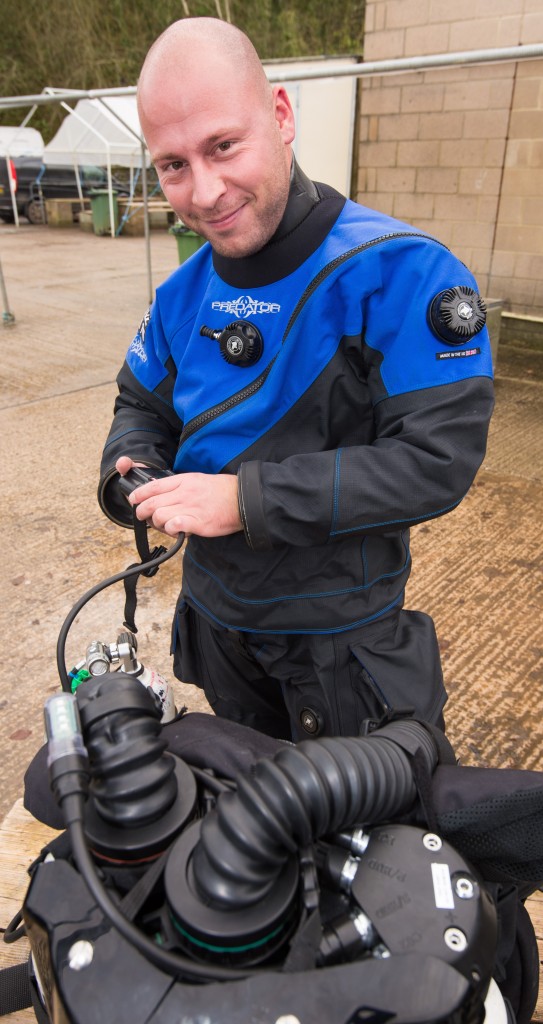 Performance testing of the RedBare CCR passed the most stringent CE tests for life support: CE 2013: 14143.
Performance testing of the RedBare CCR passed the most stringent CE tests for life support: CE 2013: 14143.
These CE tests exist to examine crucial life support functions of a rebreather and thus give confidence to divers that it will perform under a wide range of conditions.
The thread of testing can be summarised as follows:
1) Environmental challenges. The rebreather in question runs through rigorous immersion and cleaning cycles before being subject to freezing, cooking and bounce testing. If these tests are passed, with no distortion of components, the CCR may move on to the next phase.
2) Machine testing. This covers O2 tracking and stability, CO2 duration for accurate dive planning, mechanical work of breathing (how easily the gas goes around the loop), and the hydrostatic work of breathing (which looks at the relationship between counterlung and lung pressure).
All these are done at extremes of performance to provide reassurance.
3) Manned dives. Once all the numbers are in from machine testing, we can be confident that it’s safe to test it using a diver. Divers confirm that the unit is comfortable to use and all controls work as planned underwater.
4) Submission. The resulting collection of reports is known as the technical file and is assessed by a CE awarding body.
The RedBare achieved some very impressive results from the performance testing.
First of all, PO2 tracking. The test requires that with the breathing rate varying from 15-72 litres per minute, the PO2 should not vary by more than 0.06 Bar. Many factors from the physical design of the machine to the sampling rate of the cells and the control of injection solenoid combine to give this performance.
Second, mechanical work of breathing. This is the effort required to move one litre of gas through the loop. It is a good guide to the physical resistance of the hoses, absorbent, one way valves. The threshold for this is 2 joules per litre – above this, the unit would fail. The RedBare scores a class leading 0.48 Joules per litre. This is a pretty easy number to understand, but the work of breathing we experience as divers involves a lot more factors and is know as…
Third, hydrostatic work of breathing. Mechanical work of breathing is a pretty easy number to understand, but the work of breathing we experience as divers involves a lot more factors and is known as hydrostatic work of breathing. These factors include counterlung size, loop size, counterlung position, diver position plus the amount the counterlung is inflated.
For a diver swimming along flat, a back mounted counterlung will be hard to inhale and easy to exhale. The same diver with a front mounted counterlung will find the opposite. A diver with ‘over the shoulder’ will find it easy both ways (but now the chest is cluttered). It’s all about the distance between the counterlung and the ‘centroid’ of the diver’s lungs (approximately the sternum).
Change the attitude of the diver and the ‘best’ counterlung position changes, as the pressure difference between centroid and counterlung changes. Vertically, front or back mounted lungs are now easy to breathe while over the shoulder is harder.
CE testing evaluates a unit in ALL these orientations. Needless to say, fitting third party counterlungs or any other non standard major components to a unit after purchase invalidates all these tests, and the impact on it’s performance is unknown.
The RedBare uses counterlungs down the side of the diver, making them much closer to centroid. The difference this makes can be seen from comparing the same tests on RedHead (back mounted counterlung) to RedBare (counterlungs pulled down side of body).
The RedHead graph is a traditional backmounted counterlung graph – a fairly easy exhale as the gas rises naturally into the lung, with some effort required to pull it down into the lungs on inhale.
On the RedBare, exhale is above the line – no work is being done here, it’s easy to exhale as we would expect for back mounted lungs. The interesting bit here is the inhale, also above the line at the start, so the beginning on inhale is actually ‘assisted’. The maximum effort is feather light breathe compared to the RedHead (and definitely other CCRs).
Looking at the RedBare flat (in trim) graph, it’s still excellent! The important point is that the RedBare has not just passed, but excelled in performance in all orientations. The easy breathe both in and out is achieved by the new counterlung position down the sides of the diver.
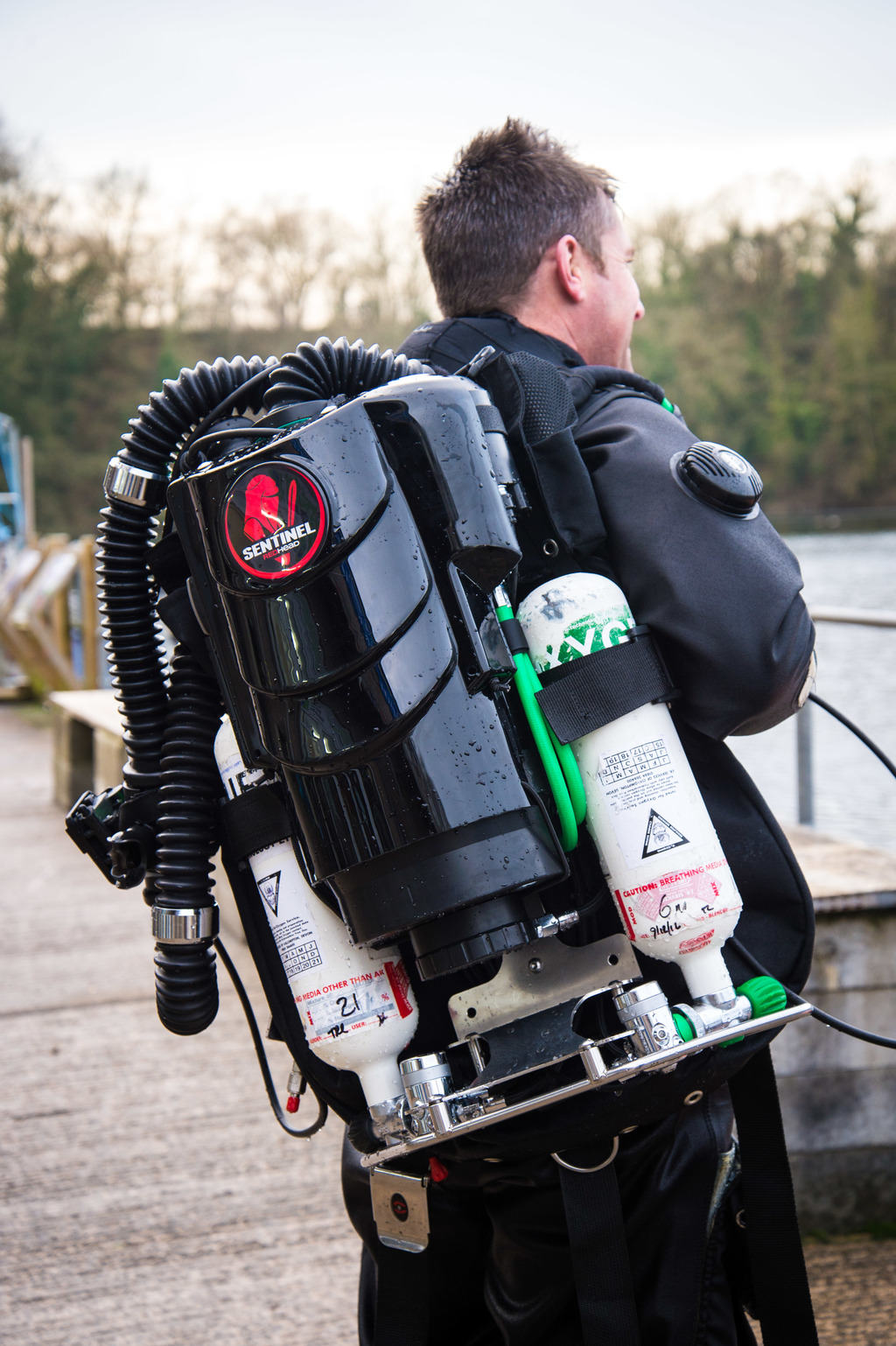 CO2 duration is tested for air at 40m and trimix at 100m, again with fierce breathing rates in 4 degree water. The time to 5mB CO2 breakthrough at these depths is 140 min and 47 min respectively. This is much higher than many other units on the market for this test. Of course our normal diving metabolic work rate comes nowhere near this test, so most divers report varyingly greater hours before they get a headache (or a CO2 reading on the RedHead and RedBare!).
CO2 duration is tested for air at 40m and trimix at 100m, again with fierce breathing rates in 4 degree water. The time to 5mB CO2 breakthrough at these depths is 140 min and 47 min respectively. This is much higher than many other units on the market for this test. Of course our normal diving metabolic work rate comes nowhere near this test, so most divers report varyingly greater hours before they get a headache (or a CO2 reading on the RedHead and RedBare!).
The overall duration for CO2 removal on the RedBare and RedHead is 4 hours derived from a test involving varying depths. No other CE rated CCR has this duration in a comparative test.
In summary, being a RAID Instructor Trainer on open circuit diving, the CCR journey was a new route for me. It was important to start it the right way with a unit that supports my needs and has the ability to grow with them, and with a manufacturer that will support me. The type of reporting and analyzing the RedBare CCR does provides me with all I need to make informed decisions in regards to my dive. Having the rear mounted secondary HUD allows my team mates to see what is going on for me to a very large degree which further supports a team diving attitude. The unit’s native build in redundancy both mechanically and electronically means that I have a degree of backup that provides choices beyond just bailing out to Open Circuit. The entire system is designed to give you every chance to finish your dive on the loop, and in reality, that is what you want. The unrivaled work of breathing of the new RedBare CCR, and the ability to hold any angle in the water without the WOB being affected, is a big big pull for me. The modularity of the electronics and ease of replacing parts makes it an excellent expedition unit, and ensures that multi day projects can be attended and completed without the fear that one single failure would cause the entire system to fall flat on its face.
Do you want to know more?
Anyone wanting to know more about the system, or if you want to try it for yourself, come see me in Malta or arrange to meet up in the UK – I would be most happy to share my enthusiasm for the unit with you!
For more information about the unit, or courses on the unit, contact me at www.DivingMatrix.co.uk, oli@divingmatrix.co.uk, or visit the VMS website directly: www.vmsrebreathers.com.
UK Divers – see the RedBare in action this weekend!
If you’re in the UK and you want to see the RedBare in action, Oli will be diving the unit at Vobster Quay on the 4th/5th February.
Gear Reviews
GEAR REVIEW – Revolutionising Diving Comfort: The Sharkskin T2 Chillproof Suit
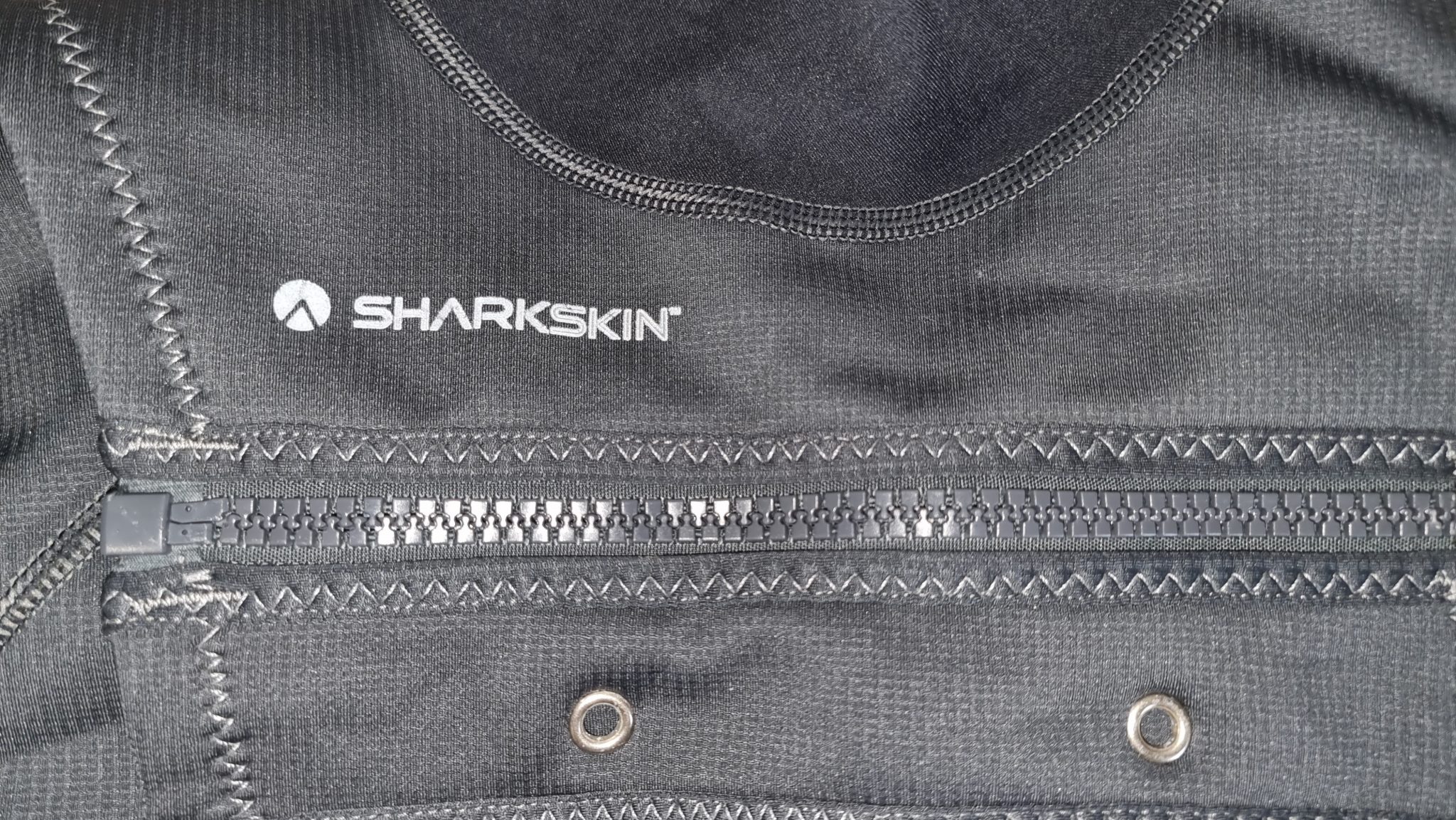
In a review written exclusively for Scubaverse.com, diver and blogger Katy Woodroffe from Katy Jane Dives takes a look at the T2 Chillproof Suit from Sharkskin.
Sharkskin wetsuits attract a lot of attention in online forums, with some divers swearing by them whilst others just can’t understand how a suit so thin and lightweight can provide the warmth they require. I too had my doubts, but I was able to put this suit to the test in one of the most challenging open water environments we know.
Embarking on an adventure in the Galapagos, I found the Sharkskin T2 Chillproof Suit to be an incredible ally. Designed to offer warmth, UV protection, and defense against the many marine stingers, this suit surpassed my initial reservations, providing a level of thermal insulation I did not expect and durability amidst the archipelago’s rugged underwater landscapes. Its lightweight, easy-to-wear design clearly sets it apart from traditional wetsuits, proving essential for divers prioritising comfort and efficiency.
Exceptional Performance in Varied Conditions
The suit’s performance was thoroughly tested in the Galapagos’ unpredictable waters. Despite its seemingly thin material, it offered extraordinary warmth and flexibility. The inclusion of Titanium Far Infrared (FIR) nano-technology within the fabric reflected my body’s heat, enveloping me in a warm embrace that countered the cold without adding bulk. This level of tech came in handy when we hit the common thermoclines, with my dive computer recording a drop of several degrees in water temperature. This, combined with the suit’s ease of use and quick-drying capabilities, in my opinion marks a significant advancement in dive gear.
However, the perception of warmth in the Sharkskin T2 Chillproof Suit can indeed vary among individuals. Divers accustomed to cooler waters may find the suit exceptionally warm and sufficient for their needs, due to their higher tolerance and acclimatisation to the cold. This aspect underscores the importance of considering personal resilience to cold and usual diving conditions when evaluating the suit’s effectiveness in providing thermal protection.
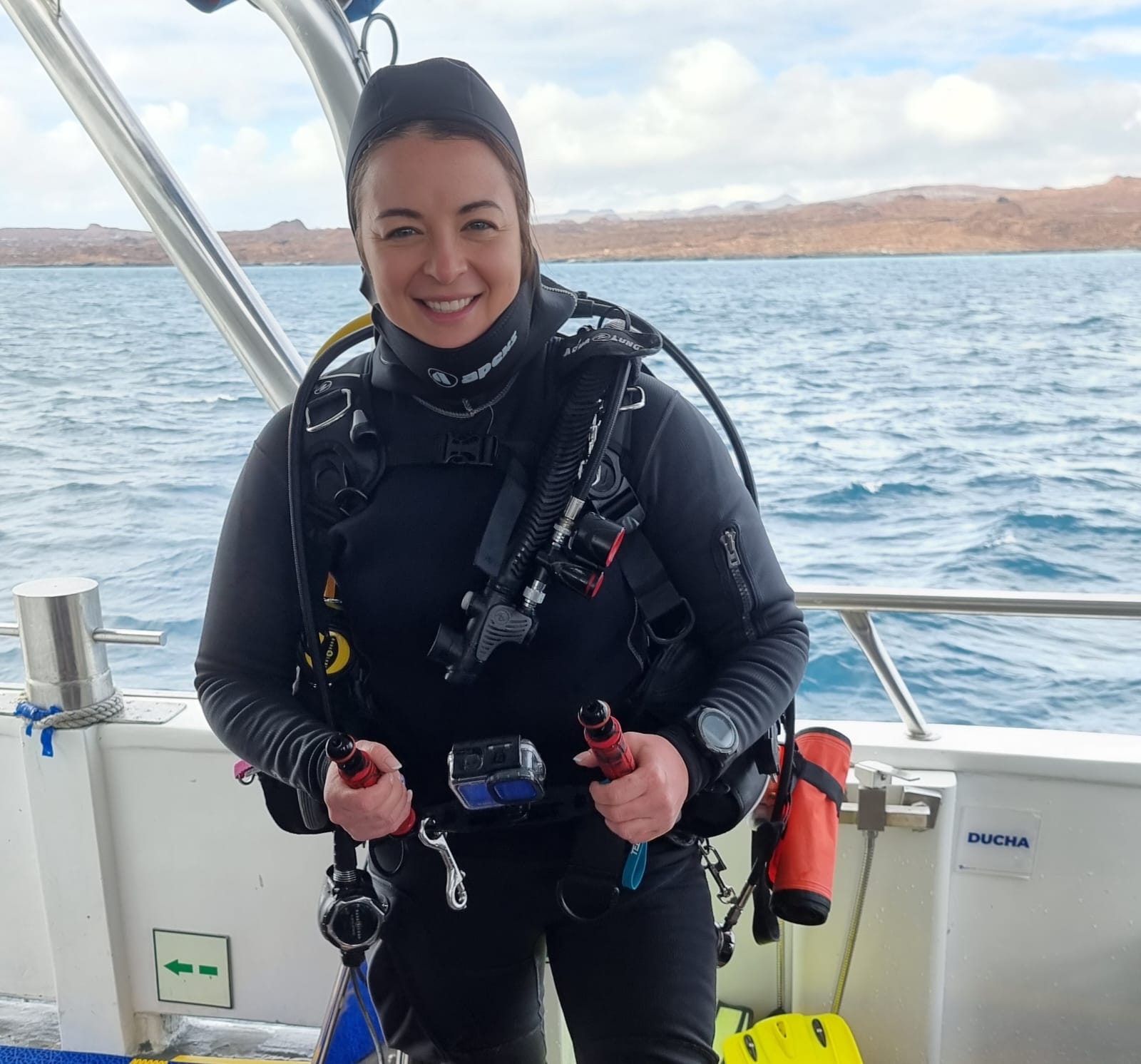
Durability Meets Innovation
Diving the volcanic underwater landscape of the Galapagos, the Sharkskin T2 Chillproof Suit proved its resilience. Engineered for both warmth and resistance to abrasion, it stands as a testament to high-quality construction and thoughtful design. I also tried out the optional accessories, including the hood and socks, which I felt complemented the suit well, and offered enhanced thermal protection and convenience.
The feature I enjoyed most about this suit was its neutral buoyancy, significantly lightening my load underwater. I found myself needing almost half the weight I typically would with a neoprene suit, making me feel incredibly free and unburdened.
It was a dream to travel with, folding up really small and didn’t take up much room in my dive bag. It was also super easy to get on and take off, even when wet, compared to your standard neoprene wetsuits (we’ve all been there), particularly when I used the socks with it too.
I also appreciate how Sharkskin has produced two styles, one for males and the other for females. The female fit was flattering, and it’s clear that the design team have worked hard to achieve this, all adding to the overall comfort of the suit.
A Worthwhile Investment
The suit is certainly priced in the premium segment, but I think it does justify its cost through the unique advanced features and excellent comfort. Its innovative features, such as the chest zip design and FIR technology, provide divers with a unique blend of warmth, flexibility, and ease of movement.
My personal journey from skepticism to trust in the Sharkskin suit has affirmed its value, making it a highly recommended choice for divers seeking excellent performance in diverse diving conditions.
Find out more about the T2 Chillproof Suit and other Sharkskin products at www.sharkskin.com.
Gear Reviews
Gear Review: Bigblue VTL2900PB Dive Torch: A Compact Powerhouse for Underwater Exploration
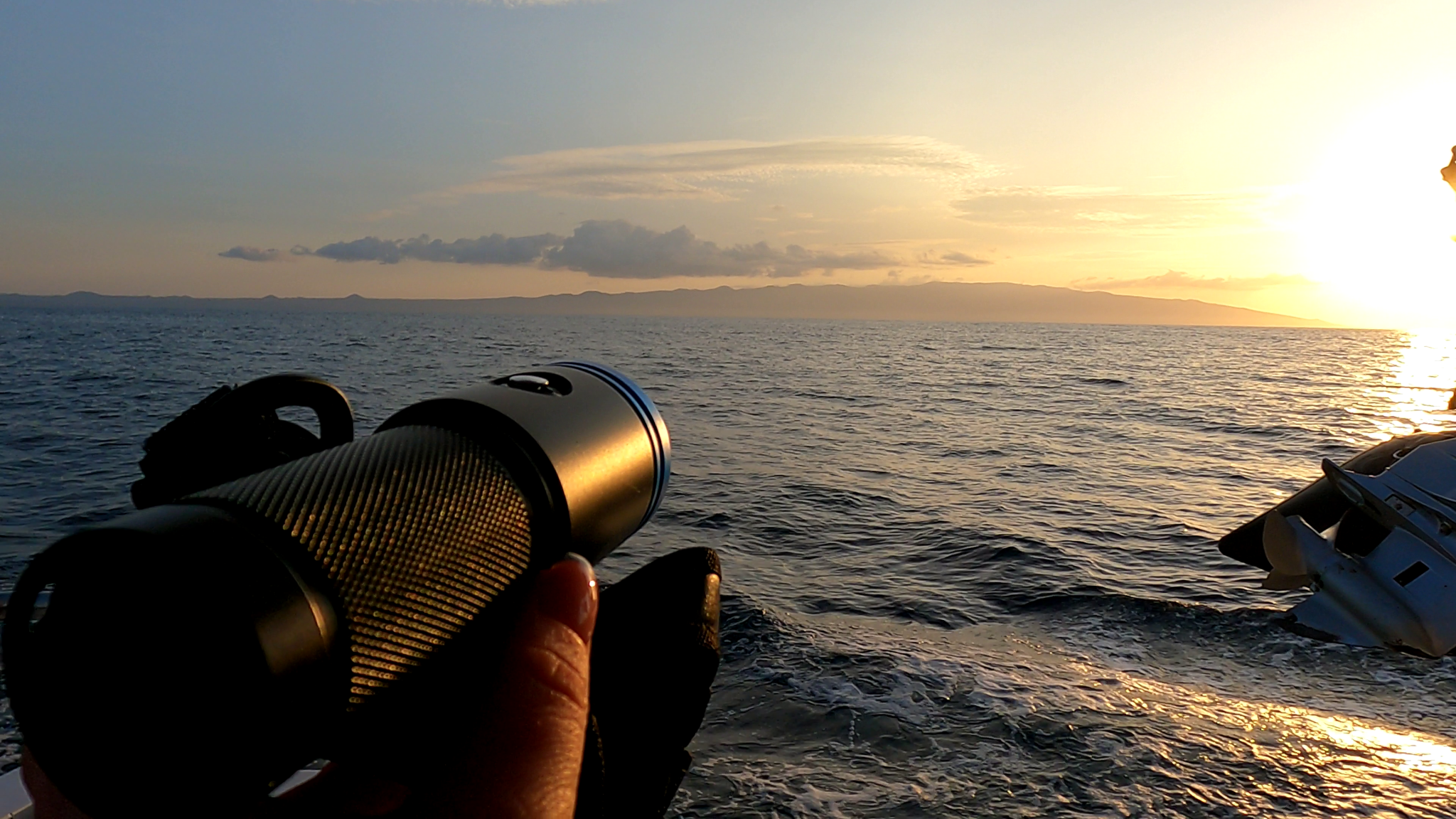
In a review written exclusively for Scubaverse.com, diver and blogger Katy Woodroffe from Katy Jane Dives takes a look at the VTL2900PB dive torch from Bigblue.
Bigblue Dive Lights has established itself as a leading manufacturer of dive lights, known for its innovative approach to underwater illumination. With a focus on creating durable, high-quality lighting solutions for divers of all levels, Bigblue combines advanced technology with user-friendly design.
Their product range, from compact torches to powerful video lights, caters to a wide spectrum of diving activities, ensuring safety and enhancing the underwater experience. The brand’s commitment to sustainability, seen in their rechargeable battery options, reflects a dedication to eco-friendly practices in the diving community.
First Impressions and Build Quality
Unboxing the sleek and compact Bigblue VTL2900PB immediately hints at its potential as a top-tier dive torch. It arrived with a comprehensive set of accessories including a Goodman glove, rechargeable battery, and charger, highlighting Bigblue’s attention to detail. While the inclusion of a dry bag is appreciated, a hard protective case might have offered better protection for this bit of gear which does come with a premium price tag.
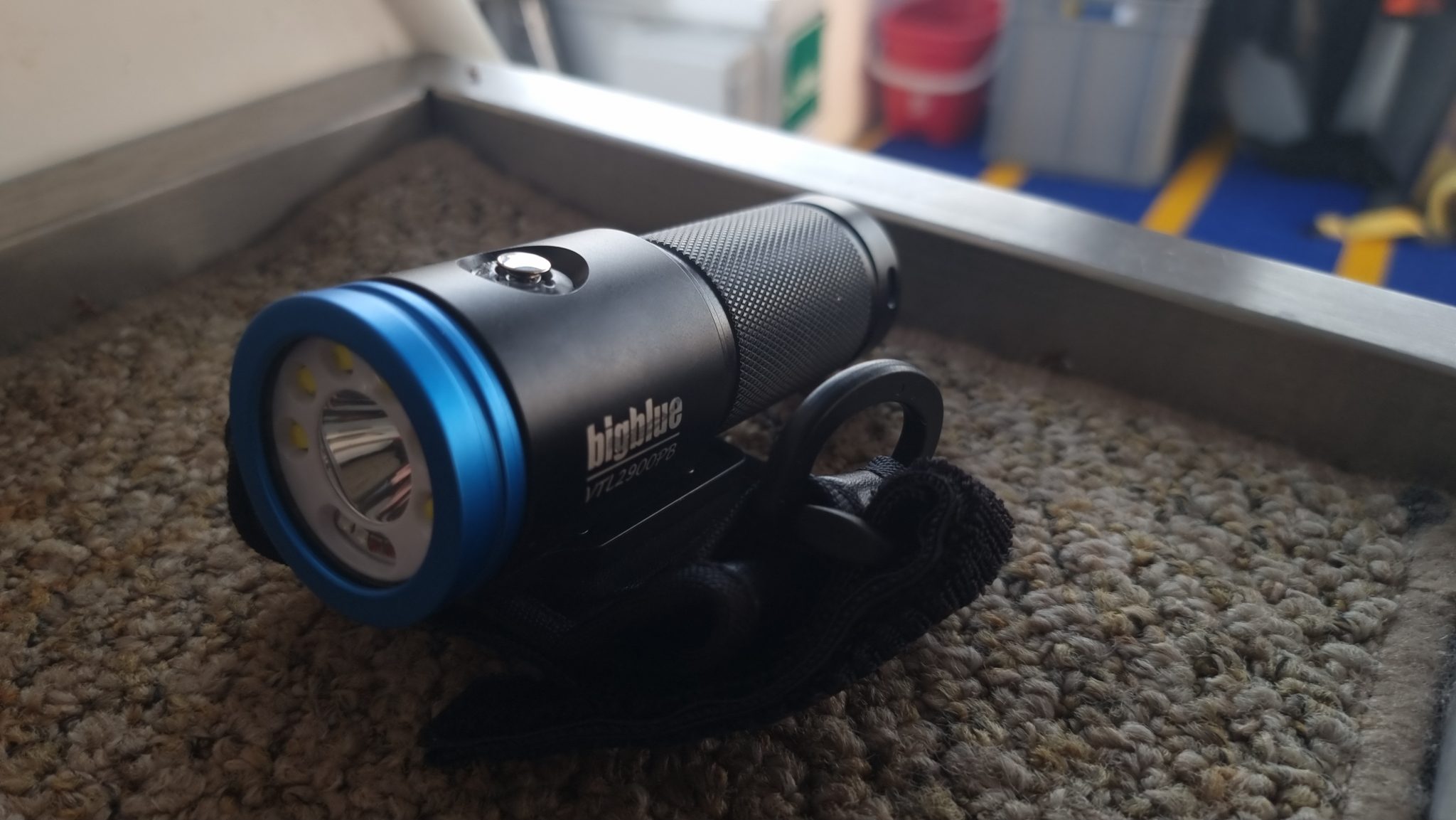
Performance and Versatility
I tested this torch in various conditions whilst diving in the Galapagos Islands and was impressed with it’s power and range of lighting, all easily accessible at the push of a button.
Underwater, the VTL2900PB’s performance shines—literally. With a brightness of 2900 lumens across a wide beam and a 1000 lumens narrow beam, visibility in murky, or plankton filled waters like those around the Galapagos Archipelago, becomes a non-issue.
Its user-friendly interface, which allows divers to swiftly toggle between modes even with gloves on, enhances the underwater experience. I found the light’s beam distance and colour rendition to be excellent. The colour temperature sits at 6500k, or a “cool white” which does a good job at delivering a true display of colours, providing vivid visuals for photography and navigation.
Its versatility extends from illuminating vast underwater landscapes for photography to subtle communication with my dive buddies through its red light mode. I found this mode particularly useful when looking into small spaces within the rocks and coral, with the hope to not make anything stir and swim for cover.
Durably built from high-quality anodised aluminium alloy, and depth tested to 100 metres, the torch is both lightweight for travel and robust enough to withstand the underwater elements. I was quite confident that this torch would hold its own on the dive platform of a liveaboard boat without me having to worry about it too much.
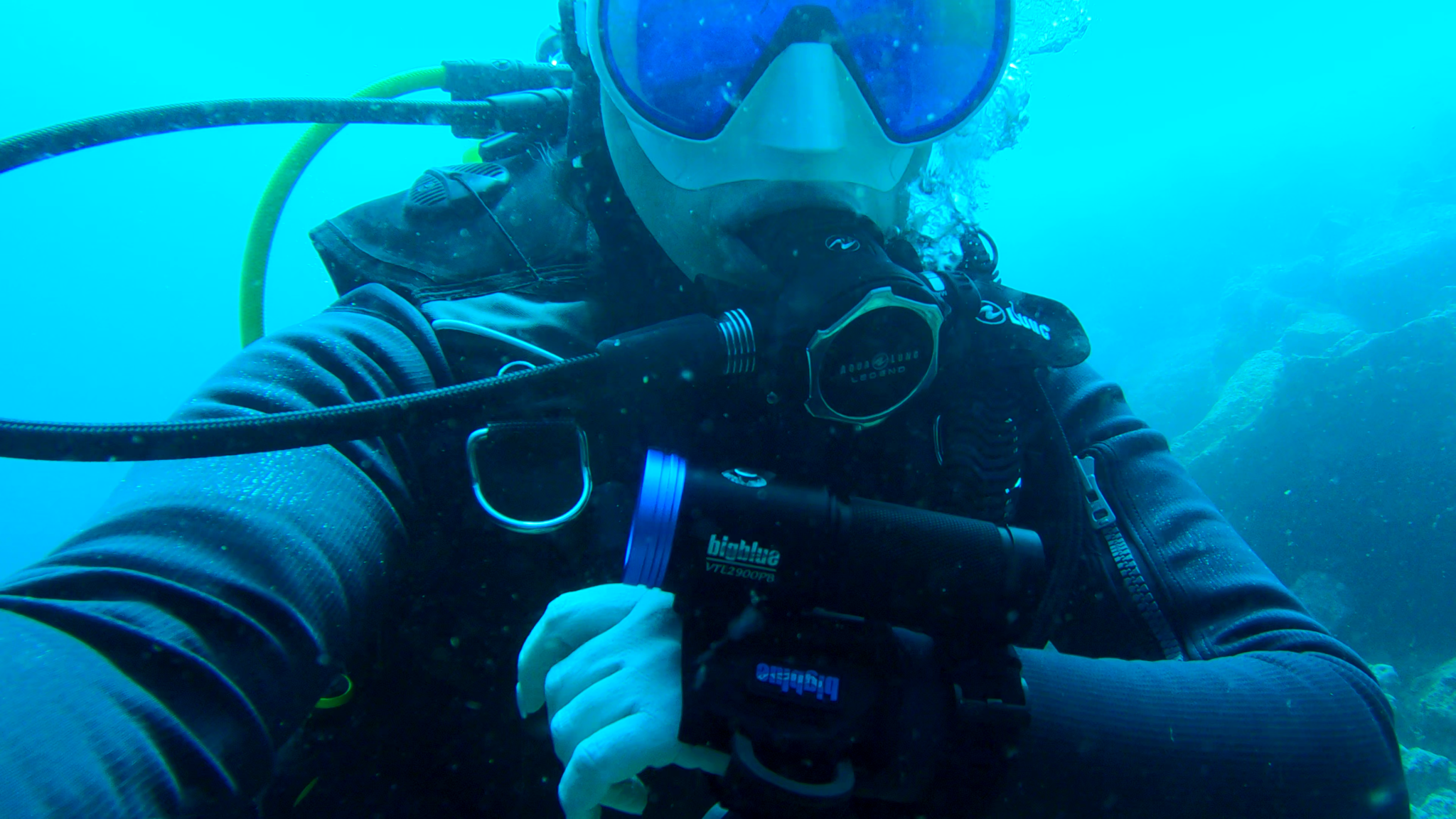
Sustainable Power
Powered by a rechargeable Li-ion battery, the VTL2900PB offers up to 1.5 hours of light on its highest setting—perfect for multiple dives. This eco-friendly approach not only ensures prolonged adventures under the sea but also aligns with sustainable diving practices.
Pricing and Value
Priced at £415, the Bigblue VTL2900PB stands out in the competitive dive torch market by offering exceptional value. Its performance, durability, and included features such as a red light and blue light for fluoro diving, make it a wise investment for divers at all levels, particularly those with an interest in photography and videography. Despite the absence of a hard case, its overall quality and functionality make it an indispensable tool for any dive.
Concluding Thoughts
The Bigblue VTL2900PB torch is a reliable, versatile companion for divers, offering a blend of powerful illumination and user-friendly features.
Its construction, long-lasting battery, and thoughtful design are evidently well researched and underscore Bigblue’s commitment to enhancing divers’ underwater experiences. For those looking to capture the undersea world in all its glory or navigate the depths with confidence, the VTL2900PB is a standout choice that promises not to disappoint.
Bigblue have been in the dive light game for years, and without a doubt, will be here for many more years to come.
-

 News3 months ago
News3 months agoHone your underwater photography skills with Alphamarine Photography at Red Sea Diving Safari in March
-

 News2 months ago
News2 months agoCapturing Critters in Lembeh Underwater Photography Workshop 2024: Event Roundup
-

 Marine Life & Conservation Blogs2 months ago
Marine Life & Conservation Blogs2 months agoCreature Feature: Swell Sharks
-

 Blogs2 months ago
Blogs2 months agoMurex Resorts: Passport to Paradise!
-

 Blogs2 months ago
Blogs2 months agoDiver Discovering Whale Skeletons Beneath Ice Judged World’s Best Underwater Photograph
-

 Gear News3 months ago
Gear News3 months agoBare X-Mission Drysuit: Ideal for Both Technical and Recreational Divers
-

 Gear Reviews2 months ago
Gear Reviews2 months agoGear Review: Oceanic+ Dive Housing for iPhone
-

 Marine Life & Conservation2 months ago
Marine Life & Conservation2 months agoSave the Manatee Club launches brand new webcams at Silver Springs State Park, Florida


